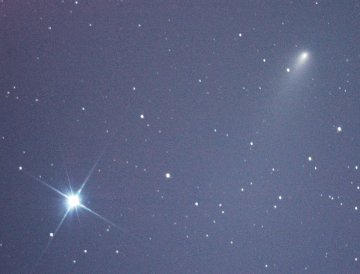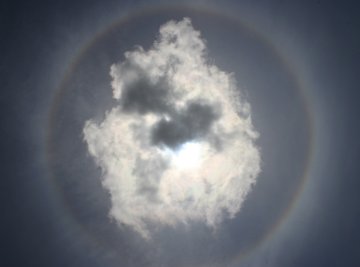 Roses. Candy. Spatulas? Make that the stars: Spaceweather PHONE for Mother's Day.
Roses. Candy. Spatulas? Make that the stars: Spaceweather PHONE for Mother's Day.
DA VINCI GLOW: As soon as the sun begins to set tonight, step outside and look west. A beautifully slender crescent moon will pop out of the twilight: sky map. Later, when the sky grows darker, you can see a lunar glow that puzzled astronomers for thousands of years until Leonardo Da Vinci figured it out: the Da Vinci Glow.
SUN SOUNDS: Sunspot 875 continues to produce C-class solar flares and shortwave radio bursts. Thomas Ashcraft is recording the sounds using a radio telescope in New Mexico: listen.
FRAGMENT C: The biggest piece of comet 73P/Schwassmann Wachmann 3 is not falling apart. Sturdy fragment C, for reasons unknown, resists crumbling. This makes it different from the other 40+ fragments of the dying comet. (continued below)

Above: Fragment C photographed on April 21st by Masa Nakamura of Otawara, Tochigi, Japan
Tonight is a good night to see fragment C. Point your telescope toward the double star zeta Herculis in the keystone of Hercules: sky map. Fragment C is passing by that star tonight, making it especially easy to find.
more images: from Mike Holloway of Van Buren, Arkansas; from Alfredo Garcia, Jr. of Tucson, Arizona; from the Astronomical Association of Cortina, Cortina d'Ampezzo, Italy; from Chris Schur of Payson, Arizona; from George Varros of Mt. Airy, Maryland; from Ugur Ikizler of Bursa, Turkey; from Eric Walker of Conon Bridge, Scotland.
SUN HALO: "Winter has lingered so long here in central California that we have had virtually no views of the disintegrating comet or anything else in the night sky," says Andy Skinner of Mariposa, California. "However, there have been sun halos for days and days." He photographed this one on April 25th:

Sun halos are a sign of tiny ice crystals in high cirrus clouds. The crystals catch the rays of the sun and bend them into a rainbow-colored circle 22 degrees in radius. Winter is not required: it's always cold enough for ice crystals to form 10 km above the ground where cirrus clouds float.
And if you see sun halos by day, be alert for moon halos by night. Moonbeams are affected by ice crystals in the same way as sunbeams. Andy Skinner caught this Moon halo on April 10th: image.

